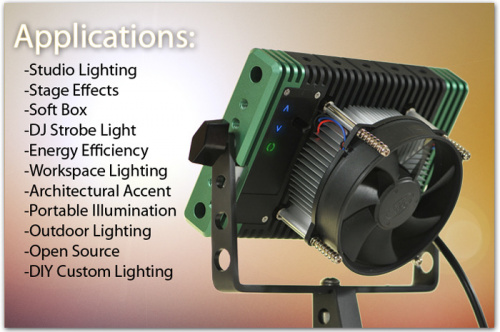Today, we have a guest post from SparkFun videographer Gregg (of Engineering Roundtable, new product post, and According to Pete "fame"). Check it out:
As the videographer here at SparkFun, I get a lot of questions about the type of equipment I use. As a general rule, I try to pick out equipment that will give me the most bang for my buck. Nowadays it's pretty easy to find affordable deals on cameras and sound recorders, but the same cannot always be said for lighting equipment. I shoot different types of videos all over the SparkFun building, and at other locations, such as Pete's dark scary basement. Therefore the lighting equipment I use needs to be lightweight, portable, and able to run on battery power. LED's fit the bill nicely, but a single 1' x 1' LED light panel can run over $1200.
ReplaceMeOpen
ReplaceMeClose
I was recently approached by Richard Haberkern, creater of the Lumapad. The Lumapad is an open source LED light pad that incorporates many of the platforms we offer here at SparkFun, such as the Electric Imp and Arduino. By incorporating the Electric Imp, the Lumipad's intensity and color temperature can all be adjusted from a smart phone. You can also network a series of lights together, and program them to do a variety of lighting effects, such as simulated lightning or strobe flashes. The Lumapad only draws 88 watts (not 1.21 gigawatts), so it can easily be run on battery power, but it puts out the equivalent of 1000 watts of tungsten power. In addition to drawing less current than other light sources, it's also much smaller. The Lumapad measures in at just 6.75", making it extremely portable, even more so than other LED options on the market.
Richard was kind enough to send me a prototype version of the Lumapad. I have been using it for two weeks now in all my videos and I absolutely love it. Check it out!







Anyone who is anxiously awaiting the Uncertain 7-Cube tutorial can now find it here
Didn't Lite Panels lock down the patent on using LED panels in the Untied States? http://nofilmschool.com/2013/01/litepanels-wins-patent-case/
Frankly, I'm really intrigued by the electric imp.
I haven't shot video for a few years so maybe my info is out of date. But a fan on a lighting instrument was a reason to pass it over for video use. The primary concern is fan noise being picked up on the audio track.
I can tell you based on experience that the fan is extremely quiet. It's barely noticeable, let alone invasive. Also, as Far_Seeker points out, it is removable. I think the fan is mostly precautionary. I have had the unit on for hours at a time, and it remains cool to the touch.
According to information on Lumapad.com the fan is removable. Also from the same link, when the fan is present its speed is controlled based on the device's internal temperature. Finally, while I have no idea what specific model fan they are using, there are DC muffin fans available that fairly quiet even when running at full speed (i.e. rated to mid-20's to mid-30's dB, similar to a low background noise room).
So taking into consideration all of the above, with the fact that this light uses much less power than conventional lighting of similar output (so significantly less waste heat is generated), I'd make an educated guess that fan noise would be appreciably less of an problem than most alternatives.
Am I missing something or is the source only open if you donate? I have been interested in doing high power LED designs and would love to see the schematics for the LED driver circuits used in this project, but I was unable to find them anywhere on the Kickstarter page or the Lumapad page. The only way I could see to get them was to donate $50.
Bet you could grow some kick-ass weed with that light dudz...
There are, in fact, open source LED grow-light projects out there. Whether you're going hard on some tomatoes or tending to your herb garden, probably worth a look.
Speaking of 1.21 Gigawatts, when are you guys going to start selling the elusive "Flux Capacitor"?
No Flux Capacitor, but you can get di-lithium crystals, Cogswell Cogs, and Photon Torpedos here
One of our engineers is working on one but I believe it's for personal use...
They better open source it once they're done or they should be punished for not following the company's model.